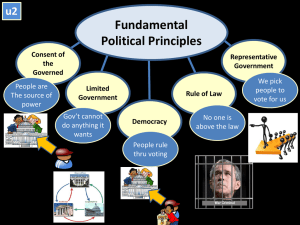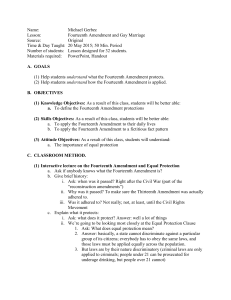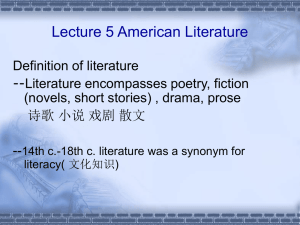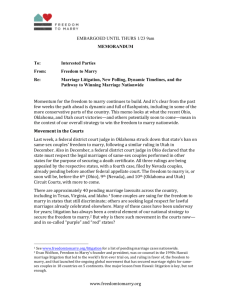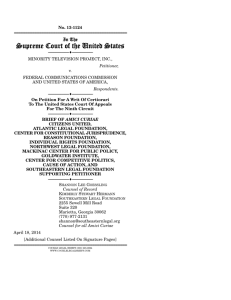Class Outline
advertisement
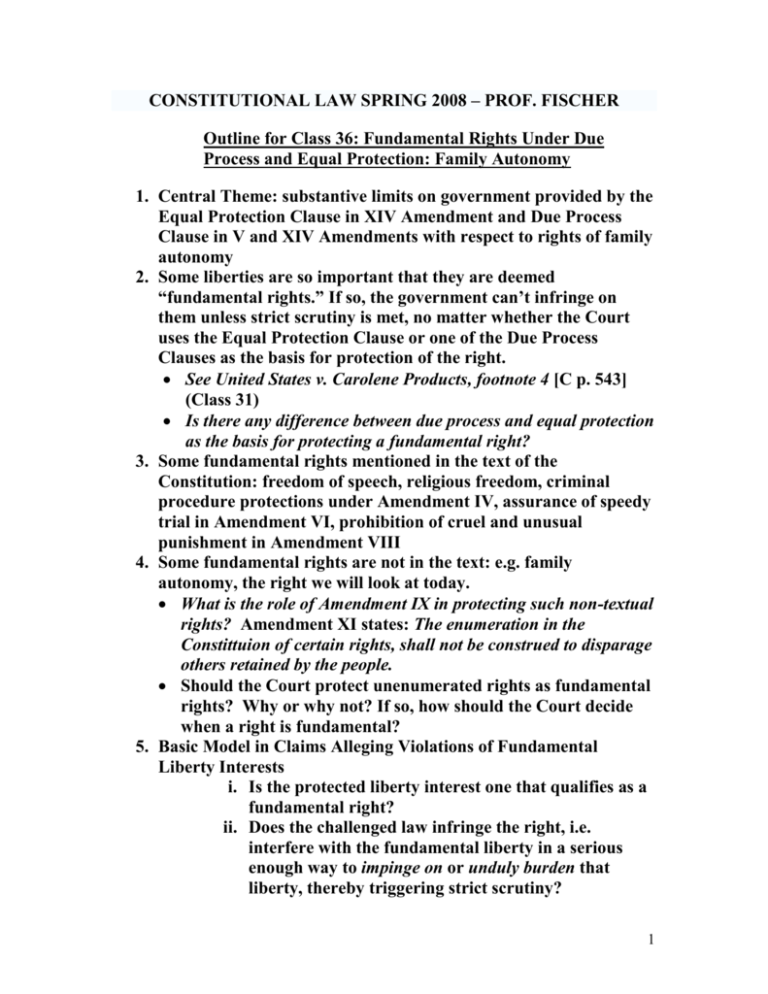
CONSTITUTIONAL LAW SPRING 2008 – PROF. FISCHER Outline for Class 36: Fundamental Rights Under Due Process and Equal Protection: Family Autonomy 1. Central Theme: substantive limits on government provided by the Equal Protection Clause in XIV Amendment and Due Process Clause in V and XIV Amendments with respect to rights of family autonomy 2. Some liberties are so important that they are deemed “fundamental rights.” If so, the government can’t infringe on them unless strict scrutiny is met, no matter whether the Court uses the Equal Protection Clause or one of the Due Process Clauses as the basis for protection of the right. See United States v. Carolene Products, footnote 4 [C p. 543] (Class 31) Is there any difference between due process and equal protection as the basis for protecting a fundamental right? 3. Some fundamental rights mentioned in the text of the Constitution: freedom of speech, religious freedom, criminal procedure protections under Amendment IV, assurance of speedy trial in Amendment VI, prohibition of cruel and unusual punishment in Amendment VIII 4. Some fundamental rights are not in the text: e.g. family autonomy, the right we will look at today. What is the role of Amendment IX in protecting such non-textual rights? Amendment XI states: The enumeration in the Constittuion of certain rights, shall not be construed to disparage others retained by the people. Should the Court protect unenumerated rights as fundamental rights? Why or why not? If so, how should the Court decide when a right is fundamental? 5. Basic Model in Claims Alleging Violations of Fundamental Liberty Interests i. Is the protected liberty interest one that qualifies as a fundamental right? ii. Does the challenged law infringe the right, i.e. interfere with the fundamental liberty in a serious enough way to impinge on or unduly burden that liberty, thereby triggering strict scrutiny? 1 If the answer to i and ii are both yes, then the court will apply strict scrutiny. Otherwise, it will apply rational basis scrutiny. 6. Fundamental rights of family autonomy i. The right to marry Major issue: when does a law impinge on or unduly burden the right to marry? (See basic model above at ii). Loving v. Virginia (1967) [C p. 821] and Zablocki v. Rehail (1978) [C p. 822] Does the regulation “significantly interfere with decisions to enter into the marital relationship”? Zablocki (1978), supra. Since marriage has been traditionally governed by the States, it may be harder to establish that a law has impinged upon or unduly burdened the right to marry than for other fundamental liberties. Examples: minimum age requirements for marriage, waiting periods for divorce, laws against bigamy, laws against incest Scope of constitutional right to marry: does this include polygamy? United States v. Reynolds, 98 U.S. 145 (1878) (Court rejected First Amendment Free Exercise Clause challenge to federal anti-bigamy act) State of Utah v. Holm, 137 P.3d 726 (2006), cert. denied, Holm v. Utah, 2007 U.S. LEXIS 2679 (U.S., Feb. 26, 2007) (holding conviction under Utah anti-bigamy statute did not violate substantive due process or equal protection) Bronson v. Swensen, 500 F.3d 1099(10th Cir. 2007) (holding that plaintiffs lacked standing to challenge Utah’s prohibition on polygamy) Scope of constitutional right to marry: does this include same-sex marriage? Court has not answered this question. Even if the scope of the constitutional fundamental right to marry does not include same-sex marriage, will laws limiting marriage 2 to one man and one woman survive rational basis scrutiny? See Goodridge v. Dep’t of Public Health, 440 Mass. 309 (Massachusetts Supreme Judicial Court 2003) (finding the answer was no); Hernandez v. Robles, 7 N.Y.3d 338 (New York Court of Appeals 2006), (finding the answer was yes); Citizens for Equal Protection v. Bruning, 455 F.3d 859 (8th Cir. 2006) (finding the answer was yes) ii. The right to custody of one’s children: rights of unmarried fathers Stanley v. Illinois (1972) [C p. 827] Lehr v. Robertson (1983) [C p. 829] Michael H. v. Gerald D. (1989) [C p. 829] iii. The right to maintain the integrity of the family What is a family? Are blood ties necessary? Compare Moore v. City of East Cleveland (1977) [C p. 835] (challenging city ordinance that prohibited a grandmother, her son, and two grandsons who were cousins, not brothers, from living together in the same home) and Village of Belle Terre v. Boraas (1974) [C p. 838] (zoning ordinance barring six unrelated college students from living in the same home) In Moore and Belle Terre, did the Court follow the basic strict scrutiny approach in model set out above? Can anyone related by blood invoke the liberty interest in maintaining the integrity of the family? E.g. Michael H. v. Gerald D. (1989) supra (involving adulterous biological father) ; Troxel v. Granville (2000) [C p. 842] Consider the role of tradition: what is the appropriate level of generality in defining the relevant tradition for substantive due process purposes? A related right: the fundamental freedom of intimate association : Roberts v. United States Jaycees (1984) 3 iv. The right of parents to control the upbringing of their children A. Lochner Era Cases Meyer v. Nebraska (1923) [C p. 839] Pierce v. Society of Sisters (1925) [C p. 840] For a contemporary portrait of Justice McReynolds by his law clerk, John Knox, see The Forgotten Memoir of John Knox (2002) (this work will be appreciated by anyone who has ever suffered a difficult boss!) B. Deference to Parents Wisconsin v. Yoder (1972) [C p. 841) Troxel v. Granville (2000) [C p. 842] C. Right not absolute Prince v. Massachusetts (1944) [C p. 841] 4


